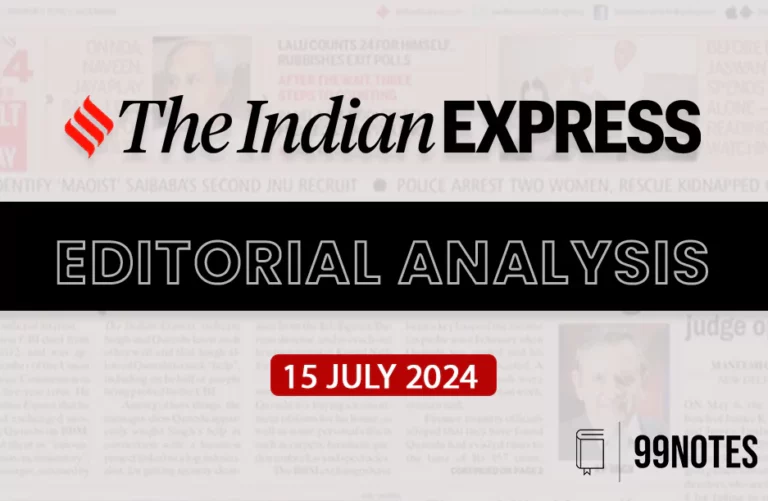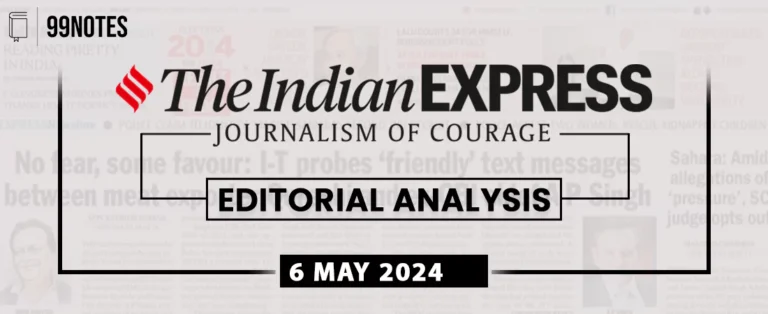13 Feb 2024 : Indian Express Editorial Analysis
Indian Express Editorial Analysis
13-February-2024
1. A science for us
| Topic: GS2 – Governance – Government policies – Interventions for development in various sectors This topic is relevant for both Prelims and Mains in the context of recent developments in Indian science and technology, including the launch of SWATI and the broader discourse on gender equity. |
| Context: |
|
More about the news:
Historical Initiatives and Reports:
- The foundation for addressing gender disparities in Indian science was laid two decades ago with the publication of a landmark report by the Indian National Science Academy (INSA).
- This report, supported by the government, highlighted discrimination in the workplace and proposed solutions, marking a significant departure from mainstream discourse.
- Subsequent initiatives, such as the Indian Academy of Sciences’ Lilavati’s Daughters and national conferences, furthered the dialogue on gender inequality in STEM.
Policy Proposals and Implementation Challenges:
- While policy proposals, including flexible working hours and research grants for women scientists, were announced with much fanfare, their implementation faced significant challenges.
- Promises made by policymakers often remained unfulfilled, reflecting a disconnect between policy intent and execution.
- The failure to establish effective implementation mechanisms hindered progress in addressing the root causes of gender disparities in academia.
Gendered Perceptions and Policy Implications:
- A deeper understanding of gendered perceptions revealed through sociological studies sheds light on the origins of existing policies and initiatives.
- The emphasis on “fixing” women through mentorship programs and awareness campaigns overlooks systemic barriers and places undue responsibility on female scientists.
- Addressing gender equity requires acknowledging discrimination and holding the overrepresented demographic accountable for perpetuating inequalities.
Emerging Policy Directions and Inclusive Practices:
- Newer initiatives, such as the Gender Advancement for Transforming Institutions (GATI) charter and the draft Science, Technology, and Innovation Policy (STIP) 2020, adopt more progressive language and inclusive frameworks.
- These policies, informed by diverse perspectives, recognize the intersectional nature of gender disparities and strive to address the unique challenges faced by marginalized groups within the scientific community.
The Role of Inter-Academy Panels and Future Prospects:
- The launch of SWATI by a panel representing multiple scientific academies signals a renewed commitment to addressing gender disparities in Indian science.
- However, past experiences caution against complacency, highlighting the need for sustained efforts and transparent, inclusive practices.
- While the inclusion of diverse gender identities in the SWATI initiative is a positive step, ensuring accountability and effectiveness remains crucial for meaningful progress.
Conclusion:
- The launch of SWATI and the broader efforts to promote gender equity in Indian science reflect a growing recognition of the need for inclusive practices and policies.
- By addressing systemic barriers and challenging gendered perceptions, the scientific community can create a more equitable and diverse environment conducive to innovation and progress.
- Continued collaboration and transparency are essential for realizing the vision of gender equality in STEM fields.
| Government of India initiatives for promoting women in science: |
|
| Practice Question: Discuss the initiatives undertaken to address gender disparities in Indian science, examining the challenges encountered in implementation and the progress achieved. (150 words/10 m) |
2. Ten years on, India and UAE
| Topic: GS2 – International Relations – Bilateral Relations This topic is relevant for both Prelims and Mains in the context of bilateral relations between India and the UAE, highlighting historical ties, diplomatic engagements, and economic cooperation. |
| Context: |
|
More about the news:
Perception of Bilateral Relations:
- Despite the substantial presence and contributions of the Indian diaspora in the UAE, bilateral relations between India and the Emirates were perceived as lacking adequate political capital investment.
- This sentiment persisted, with the last prime ministerial visit from India occurring in 1981.
- The success of Indian entrepreneurship contrasted with perceived neglect from Indian policymakers, prompting calls for greater engagement and strategic cooperation between the two countries.
Prime Minister Narendra Modi’s Visit:
- Prime Minister Narendra Modi’s historic visit to the UAE in August 2015 marked a turning point in bilateral relations.
- The warm reception from Emirati leadership and the signing of a Joint Statement signaled a commitment to elevating the relationship to a comprehensive strategic partnership.
- This visit laid the groundwork for significant initiatives across various sectors, including trade, security, infrastructure, and education.
Progress and Achievements:
- Subsequent visits and agreements between India and the UAE have demonstrated tangible progress in strengthening bilateral ties.
- Initiatives such as the Comprehensive Economic Partnership Agreement (CEPA), increased investment, and cooperation in areas like energy transition and education underscore the depth and breadth of the partnership.
- The establishment of an Indian Institute of Technology-Delhi campus in Abu Dhabi further solidifies collaborative efforts in education and research.
Symbolic Gestures and Community Engagement:
- Symbolic gestures, such as the allocation of land for the construction of a temple in Abu Dhabi, reflect the growing cultural and social ties between India and the UAE.
- The responsiveness of Emirati leadership to the needs and aspirations of the Indian community underscores the importance of community engagement in fostering closer relations.
Outlook and Future Prospects:
- Prime Minister Modi’s upcoming visit to the UAE reaffirms the commitment to strengthening bilateral ties and addressing remaining areas of cooperation.
- The dedication ceremony at the BAPS Hindu Temple in Abu Dhabi symbolizes the fulfillment of longstanding requests and aspirations of the Indian community.
- As both countries continue to deepen their partnership, the prospects for mutual growth and prosperity remain promising, paving the way for a flourishing relationship in the years ahead.
| What are Different Challenges in India-UAE Relations? |
Trade Barriers Impacting Indian Exports:
Chinese Economic Influence in the UAE:
Challenges of the Kafala System:
Concerns Over UAE’s Financial Support to Pakistan:
Diplomatic Balancing Act Amid Regional Conflicts:
|
| PYQ: The question of India’s Energy Security constitutes the most important part of India’s economic progress. Analyze India’s energy policy cooperation with West Asian Countries. (250 words/15m) (UPSC CSE (M) GS-2 2017) |
| Practice Question: Analyze the significance of Prime Minister Narendra Modi’s visits to the UAE and the outcomes of bilateral agreements in elevating the relationship to a comprehensive strategic partnership. (250 words/15 m) |
For Enquiry

13 February 2024 : The Hindu Editorial Notes PD

13 Feb 2024 : Indian Express Editorial Analysis

13 February 2024 : PIB Summary for UPSC

12 Feb 2024 : Daily Current Affairs Quiz

12 Feb 2024 : Daily Answer Writing

12 Feb 2024 : Daily Current Affairs

12 Feb 2024 : Indian Express Editorial Analysis

12 February 2024 : The Hindu Editorial Notes PDF

12 February 2024 : PIB Summary for UPSC

10 Feb 2024 : Daily Current Affairs Quiz
Feb 2024 The Hindu 13 February 2024 : The Hindu Editorial Notes PD The Hindu Editorial
13-February-2024
1. A global alliance to bridge the gender equity gap
Topic:…
Indian Express 13 Feb 2024 : Indian Express Editorial Analysis Indian Express Editorial Analysis
13-February-2023
1. A science for us
Topic: GS2 – Governance…
feb 2024 PIB 13 February 2024 : PIB Summary for UPSC PIB Summary for UPSC
13-February -2024
1. Union Minister G Kishan Reddy inaugurate regional centre…
Daily Quiz 12 Feb 2024 : Daily Current Affairs Quiz 12 Feb 2024 : Daily Quiz…
mains answer writing 12 Feb 2024 : Daily Answer Writing Mains Answer Writing
12-February-2024
Q1) “Water scarcity threatens economic and social gains…
Daily Current Affairs 12 Feb 2024 : Daily Current Affairs Daily Current Affairs
12-February-2024- Top News of the Day
1. Great Indian Bustards give Nandyal a…
Indian Express 12 Feb 2024 : Indian Express Editorial Analysis Indian Express Editorial Analysis
12-February-2023
1. CLASSROOM VS COACHING
Topic: GS2 – Social…
Feb 2024 The Hindu 12 February 2024 : The Hindu Editorial Notes PDF The Hindu Editorial
12-February-2024
1. A privileged strategic partnership, without a gulf
Topic:…
feb 2024 PIB 12 February 2024 : PIB Summary for UPSC PIB Summary for UPSC
12-February -2024
1. Birth anniversary of Swami Dayanand Saraswati
Topic:…
Daily Quiz 10 Feb 2024 : Daily Current Affairs Quiz 10 Feb 2024 : Daily Quiz…



